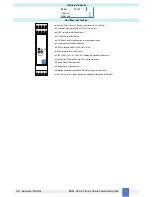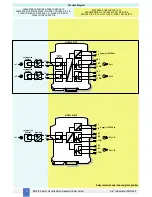
8
D1130
- Switch / Proximity Detector Repeater Relay Output
G.M. International ISM0048-8
Start-up
Before powering the unit check that all wires are properly connected, particularly supply conductors and their polarity, input and output wires, also check that Intrinsically Safe conductors
and cable trays are segregated (no direct contacts with other non I.S. conductors) and identified either by color coding, preferably blue, or by marking. Check conductors for exposed
wires that could touch each other causing dangerous unwanted shorts. Turn on power, the “power on” green led must be lit, status and fault led on each channel must be in accordance
with condition of the corresponding input line. If possible close and open input lines one at time checking the corresponding status and fault leds condition as well as output to be correct.
Power Dissipation of D1130 Isolators
Section “Technical Data” of D1130 isolator specifies the current consumption (maximum current from the nominal power supply); this data serves to dimension the current rating of the
power supply unit. Section “Technical Data” indicates also the maximum power consumption (maximum power required from the power supply in the worst (abnormal) operating
conditions like, short circuit on the outputs and on the inputs terminals.
The power dissipated
Pd
inside the enclosure for analog signal isolators is:
Pd = Current Consumption (A) * Supply Voltage (V) - Power Dissipated into the input/output loads
Digital signal isolators have lower dissipation than analog signal isolators, in addition 2 channels barriers (D1130D) have higher dissipation than single channel units (D1130S).
Isolators are not running at the maximum current all at the same time, the average power consumption of a multitude of isolators can be considered to be only 70 % of the value obtained
from the section “Technical Data”. Considering the 1/3 load power and the 70 % above discussed, the power effectively dissipated internally by the isolators can therefore become ½ of
the actual power delivered by the power supply. Digital barriers dissipate all the supply power inside the enclosure consequently the total power dissipation into a cabinet, with mixed
analog and digital barriers, is determined by the number of channels more than by the number of isolator enclosures. The following tables give advises for the DIN rail orientation
(vertical or horizontal) of the barriers mounting, D1130D (double channel) and D1130S (single channel) isolators, installed on DIN rail or custom board assembly.
A)
Cabinet with Natural Ventilation
Maximum recommended ambient temperature in °C depending on barrier type and installation method:
Installation in Cabinet
Any orientation
Vertical
Horizontal
Installation of Multiple units with DIN-rail Bus
Single unit Installation
Type of Isolator
Vertical
Horizontal
Installation on Custom Boards
B)
Cabinet with Forced Ventilation
Maximum recommended ambient temperature in °C depending on barrier type and installation method:
Any orientation
Vertical
Horizontal
Installation of Multiple units with DIN-rail Bus
Single unit Installation
Type of Isolator
60°C
40°C
45°C
Vertical
Horizontal
Installation on Custom Boards
45°C
50°C
D1130S
60°C
30°C
35°C
D1130S
60°C
Not recommended
(1)
30°C
D1130D
35°C
40°C
30°C
35°C
(1)
Installation is not recommended since it would significantly shorten the units life and increase the probability of failures.
60°C
40°C
45°C
45°C
50°C
D1130D
Installation
D1130 series are AC supply switch/proximity detector repeaters housed in a plastic enclosure suitable for installation on T35 DIN Rail according to EN50022.
D1130 unit can be mounted with any orientation over the entire ambient temperature range, see section “Installation in Cabinet” and "Installation of Electronic Equipments in Cabinet"
Instruction Manual D1000 series for detailed instructions.
Electrical connection of conductors up to 2.5 mm² are accommodated by polarized plug-in removable screw terminal blocks which can be plugged in/out into a powered unit
without suffering or causing any damage
(for Zone 2 or Division 2 installations check the area to be nonhazardous before servicing)
.
The wiring cables have to be proportionate in base to the current and the length of the cable.
On the section “Function Diagram” and enclosure side a block diagram identifies all connections and configuration DIP switches.
Identify the number of channels of the specific card (e.g. D1130S is a single channel model and D1130D is a dual channel model), the function and location of each connection terminal
using the wiring diagram on the corresponding section, as an example:
Connect AC power supply (85 to 250 Vac, 48 to 400 Hz) at terminal “3” and “4” (limit supply voltage to Um 250 Vrms for Intrinsic Safety applications).
For Model D1130S connect common relay contact output of channel 1 at terminal “1”, normally closed contact at terminal “8” and normally opened contact at terminal “2”.
For Model D1130D connect common relay contact output of channel 2 at terminal “5”, normally closed contact at terminal “7” and normally opened contact at terminal “6”.
For Model D1130S connect proximity sensor or voltage free contact at terminal “13” for positive and “14” for negative.
For Model D1130D in addition to channel 1 connections above, connect terminal “15” for positive and “16” for negative on channel 2.
Intrinsically Safe conductors must be identified and segregated from non I.S. and wired in accordance to the relevant national/international installation standards
(e.g. EN/IEC60079-14 Electrical apparatus for explosive gas atmospheres - Part 14: Electrical installations in hazardous areas (other than mines), BS 5345 Pt4, VDE 165,
ANSI/ISA RP12.06.01 Installation of Intrinsically Safe System for Hazardous (Classified) Locations, National Electrical Code NEC ANSI/NFPA 70 Section 504 and 505,
Canadian Electrical Code CEC), make sure that conductors are well isolated from each other and do not produce any unintentional connection.
Connect SPDT relay contacts checking the load rating to be within the contact maximum rating (2 A, 250 V, 500 VA 80 W resistive load).
The enclosure provides, according to EN60529, an IP20 minimum degree of mechanical protection (or similar to NEMA Standard 250 type 1) for indoor installation, outdoor installation
requires an additional enclosure with higher degree of protection (i.e. IP54 to IP65 or NEMA type 12-13) consistent with the effective operating environment of the specific installation.
Units must be protected against dirt, dust, extreme mechanical (e.g. vibration, impact and shock) and thermal stress, and casual contacts.
If enclosure needs to be cleaned use only a cloth lightly moistened by a mixture of detergent in water.
Electrostatic Hazard: to avoid electrostatic hazard, the enclosure of D1130 must be cleaned only with a damp or antistatic cloth.
Any penetration of cleaning liquid must be avoided to prevent damage to the unit. Any unauthorized card modification must be avoided.
According to EN61010, D1130 series must be connected to supply non exceeding category II, pollution degree II overvoltage limits.
Relay output contact must be connected to loads non exceeding category II, pollution degree II overvoltage limits.
Warning: de-energize main power source (turn off power supply voltage) and disconnect plug-in terminal blocks before opening the enclosure to avoid electrical shock
when connected to live hazardous potential
.




























